Role of slow delayed rectifying potassium current in dynamics of repolarization and electrical memory in swine ventricles
- PMID: 24682806
- PMCID: PMC10717138
- DOI: 10.1007/s12576-014-0310-2
Role of slow delayed rectifying potassium current in dynamics of repolarization and electrical memory in swine ventricles
Abstract
Dynamics of repolarization, quantified as restitution and electrical memory, impact conduction stability. Relatively less is known about role of slow delayed rectifying potassium current, I(Ks), in dynamics of repolarization and memory compared to the rapidly activating current I(Kr). Trans-membrane potentials were recorded from right ventricular tissues from pigs during reduction (chromanol 293B) and increases in I(Ks) (mefenamic acid). A novel pacing protocol was used to explicitly control diastolic intervals to quantify memory. Restitution hysteresis, a consequence of memory, increased after chromanol 293B (loop thickness and area increased 27 and 38 %) and decreased after mefenamic acid (52 and 53 %). Standard and dynamic restitutions showed an increase in average slope after chromanol 293B and a decrease after mefenamic acid. Increase in slope and memory are hypothesized to have opposite effects on electrical stability; therefore, these results suggest that reduction and enhancement of I(Ks) likely also have offsetting components that affect stability.
Figures
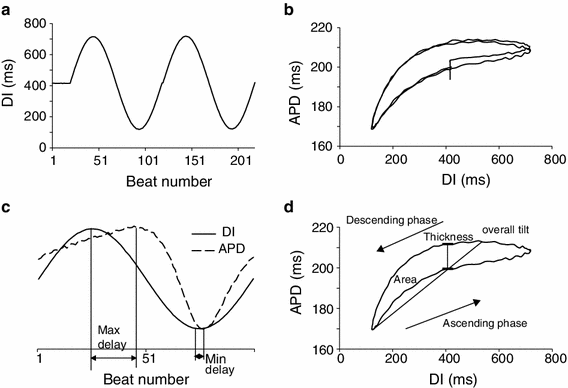
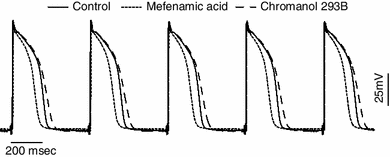
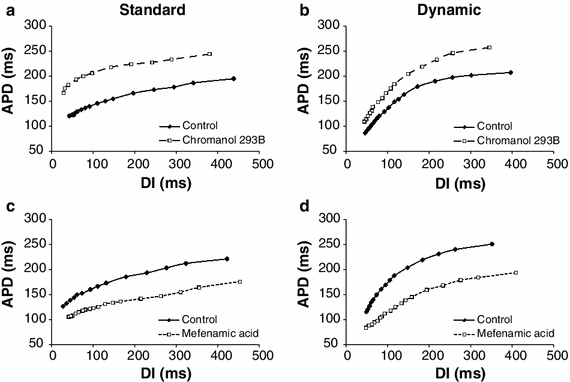
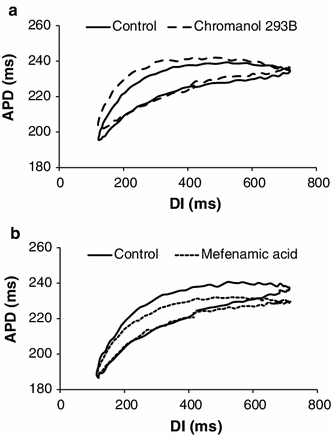
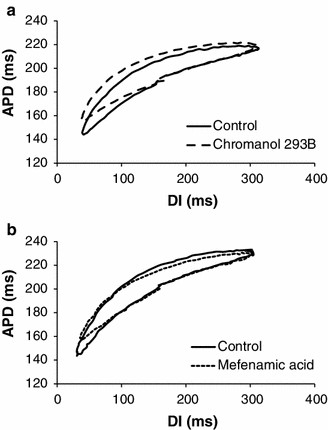
Similar articles
-
Effects of the I(Kr)-blocking agent dofetilide and of the I(Ks)-blocking agent chromanol 293b on regional disparity of left ventricular repolarization in the intact canine heart.J Cardiovasc Pharmacol. 2002 Mar;39(3):460-7. doi: 10.1097/00005344-200203000-00018. J Cardiovasc Pharmacol. 2002. PMID: 11862126
-
IKs blockade reduces dispersion of repolarization in heart failure.Heart Rhythm. 2005 Jul;2(7):731-8. doi: 10.1016/j.hrthm.2005.04.015. Heart Rhythm. 2005. PMID: 15992730
-
Density and kinetics of I(Kr) and I(Ks) in guinea pig and rabbit ventricular myocytes explain different efficacy of I(Ks) blockade at high heart rate in guinea pig and rabbit: implications for arrhythmogenesis in humans.Circulation. 2001 Aug 21;104(8):951-6. doi: 10.1161/hc3401.093151. Circulation. 2001. PMID: 11514385
-
Pharmacology of cardiac potassium channels.Adv Pharmacol. 2010;59:93-134. doi: 10.1016/S1054-3589(10)59004-5. Adv Pharmacol. 2010. PMID: 20933200 Review.
-
Theoretical possibilities for the development of novel antiarrhythmic drugs.Curr Med Chem. 2004 Jan;11(1):1-11. doi: 10.2174/0929867043456296. Curr Med Chem. 2004. PMID: 14754422 Review.
Cited by
-
Sensitivity Analysis of Ion Channel Conductance on Myocardial Electromechanical Delay: Computational Study.Front Physiol. 2021 Aug 27;12:697693. doi: 10.3389/fphys.2021.697693. eCollection 2021. Front Physiol. 2021. PMID: 34512377 Free PMC article.
-
The electrical restitution of the non-propagated cardiac ventricular action potential.Pflugers Arch. 2024 Jan;476(1):9-37. doi: 10.1007/s00424-023-02866-0. Epub 2023 Oct 3. Pflugers Arch. 2024. PMID: 37783868 Free PMC article. Review.
-
Restitution slope is principally determined by steady-state action potential duration.Cardiovasc Res. 2017 Jun 1;113(7):817-828. doi: 10.1093/cvr/cvx063. Cardiovasc Res. 2017. PMID: 28371805 Free PMC article.
-
Characterization of the Electrophysiologic Remodeling of Patients With Ischemic Cardiomyopathy by Clinical Measurements and Computer Simulations Coupled With Machine Learning.Front Physiol. 2021 Jul 14;12:684149. doi: 10.3389/fphys.2021.684149. eCollection 2021. Front Physiol. 2021. PMID: 34335294 Free PMC article.
-
T-World: A highly general computational model of a human ventricular myocyte.bioRxiv [Preprint]. 2025 Mar 28:2025.03.24.645031. doi: 10.1101/2025.03.24.645031. bioRxiv. 2025. PMID: 40196542 Free PMC article. Preprint.
References
-
- Abi-Gerges N, Small BG, Lawrence CL, Hammond TG, Valentin JP, Pollard CE. Gender differences in the slow delayed (IKs) but not in inward (IK1) rectifier K+ currents of canine Purkinje fibre cardiac action potential: key roles for IKs, beta-adrenoceptor stimulation, pacing rate and gender. Br J Pharmacol. 2006;147(6):653–660. doi: 10.1038/sj.bjp.0706491. - DOI - PMC - PubMed
-
- Cheng JH, Kodama I. Two components of delayed rectifier K+ current in heart: molecular basis, functional diversity, and contribution to repolarization. Acta Pharmacol Sin. 2004;25(2):137–145. - PubMed
-
- Lu Z, Kamiya K, Opthof T, Yasui K, Kodama I. Density and kinetics of I(Kr) and I(Ks) in guinea pig and rabbit ventricular myocytes explain different efficacy of I(Ks) blockade at high heart rate in guinea pig and rabbit: implications for arrhythmogenesis in humans. Circulation. 2001;104(8):951–956. doi: 10.1161/hc3401.093151. - DOI - PubMed
-
- Singh BN. Control of cardiac arrhythmias by lengthening repolarization. Mount Kisco: Futura; 1988.
Publication types
MeSH terms
Substances
LinkOut - more resources
Full Text Sources
Other Literature Sources
Medical

